Maybe it was my Asian upbringing that taught me never to waste food, as my family used and ate every part of the vegetable, fish, chicken, pig, or cow that we brought home.
Or maybe it’s my ever-growing curiosity when it comes to food from the land… but when I walk around the garden, looking at all my thriving plants, I always think, Can I eat that?
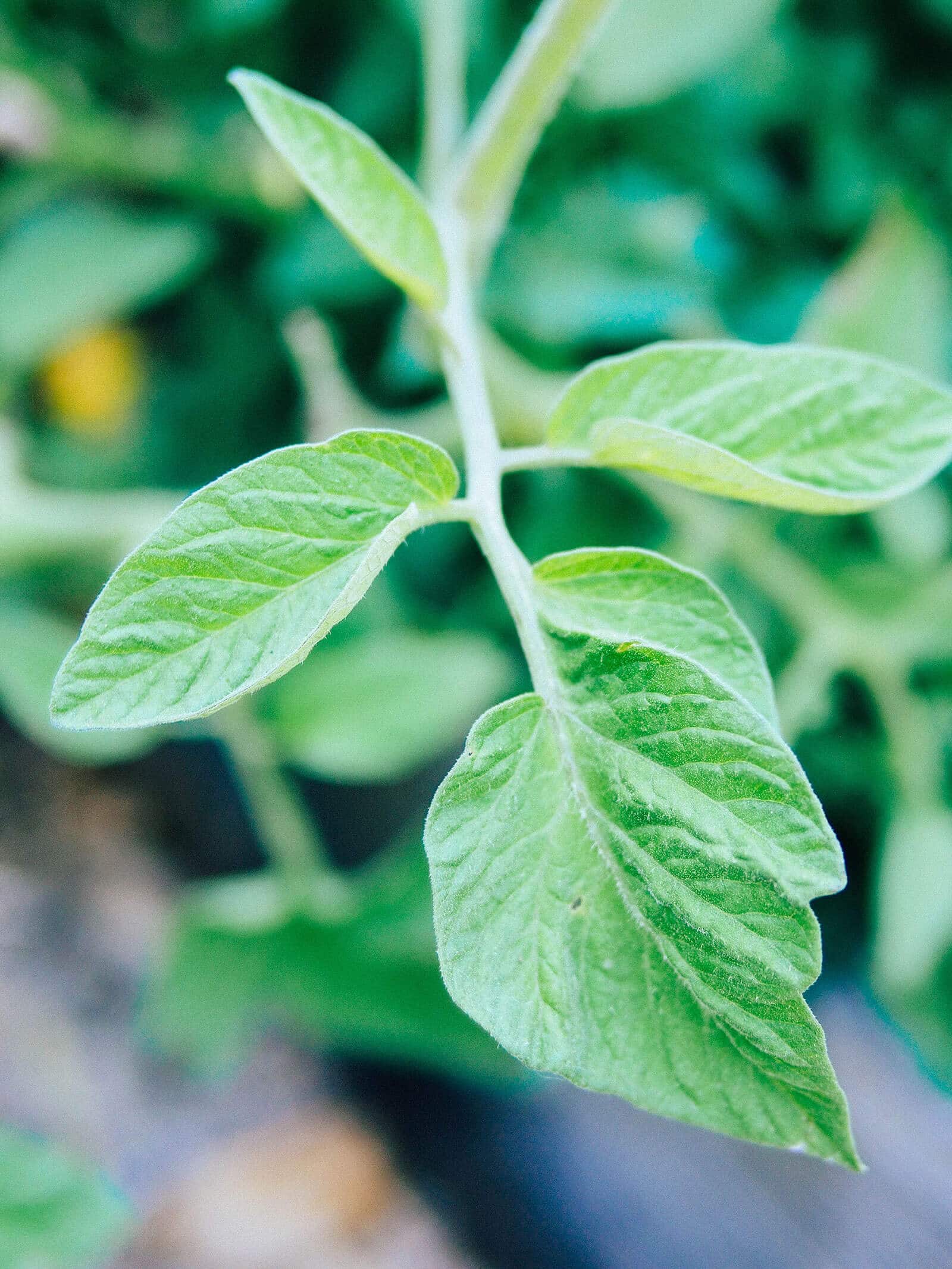
And by “that,” I mean the unconventional parts of the plant that you typically don’t think to eat. This was how I came to love artichoke stems, leek greens, and cucumber leaves, parts that are normally discarded or composted, but are in fact quite tasty.
Worth a read: 11 Vegetables You Grow That You Didn’t Know You Could Eat
So one day, when I was walking by my tomato plants, I started wondering whether the leaves were edible or not.
With vines that sometimes grow to 10 feet long, it seemed like such a waste that the leaves weren’t used when the amount of fruit seemed so small in proportion.
It got me thinking… Why don’t we eat tomato leaves?
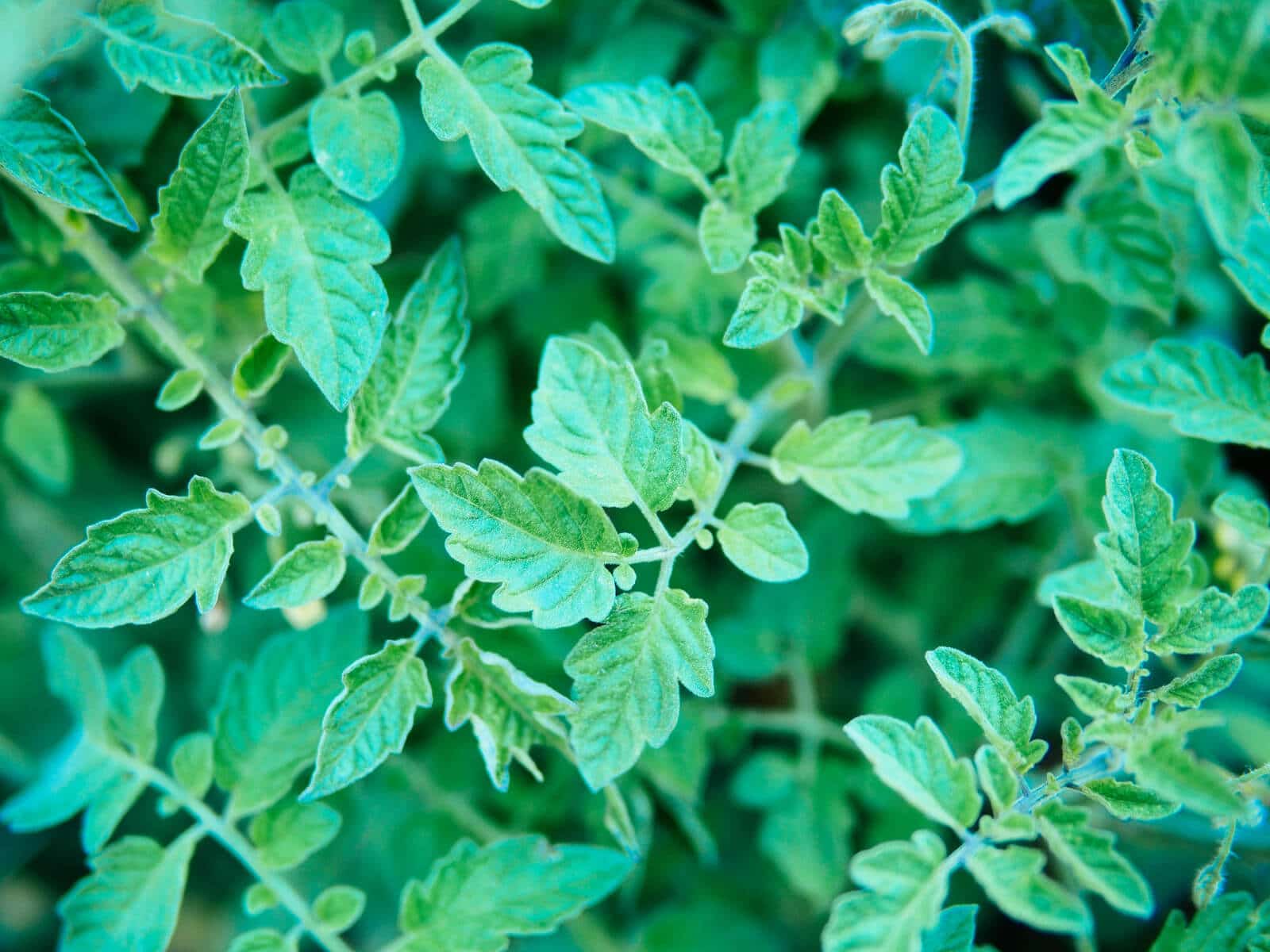
Popular culture has taught us that tomato leaves are part of the “deadly nightshade” family and thus, they must be poisonous. But I bet that more than a few people, if asked, would have no idea what that even means. It’s just what’s known. No questions asked—but we need to ask.
What is a nightshade, why are the leaves poisonous but not the fruit, and why don’t we see bunches of leaves in the supermarket if they aren’t poisonous?
Let’s take a look at all the myths surrounding the Solanaceae family and explore the science that says otherwise.
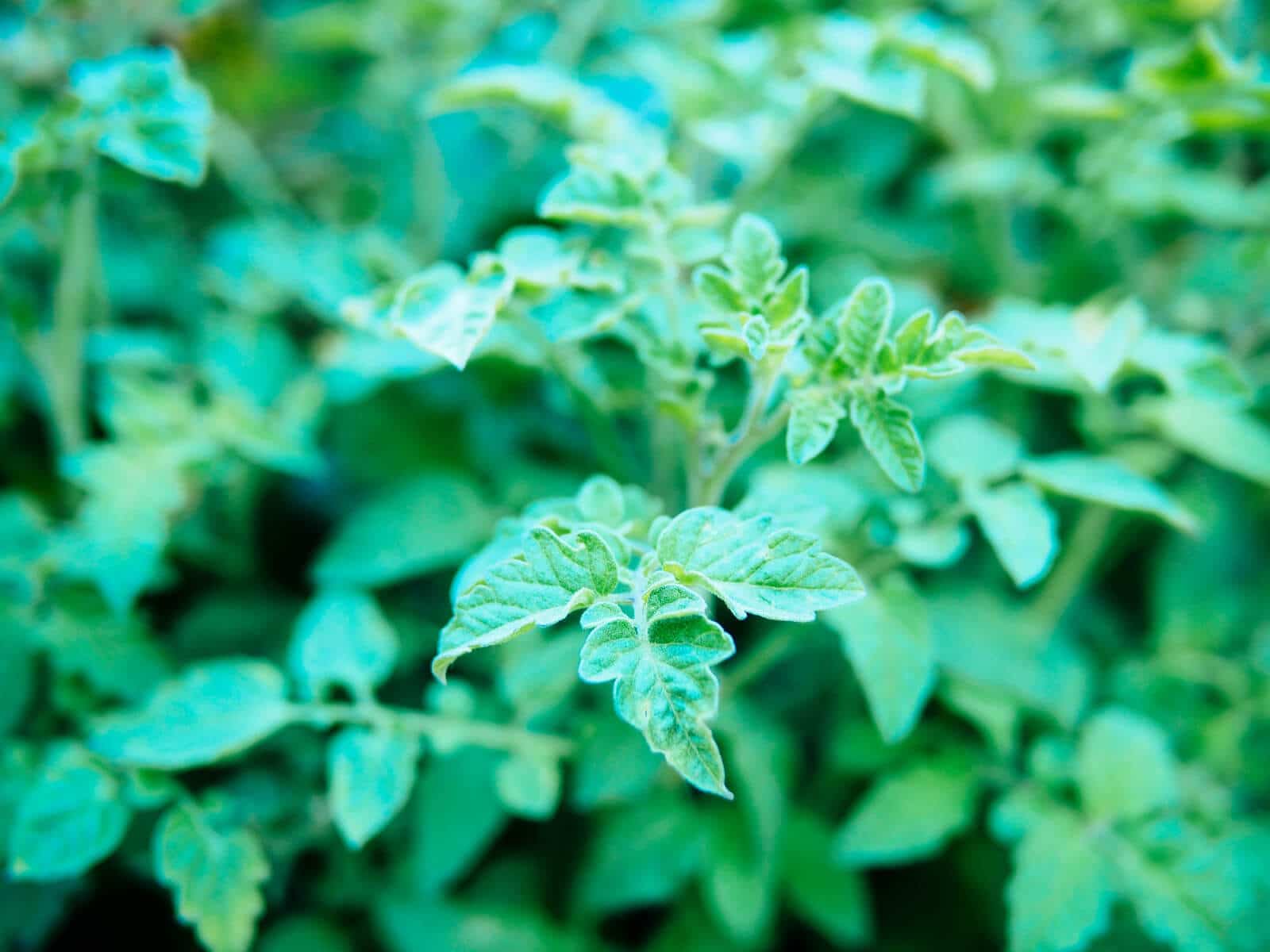
Myth #1: Nightshades are highly poisonous, so tomato leaves must be poisonous too.
When referring to the Solanaceae family of plants, many people call it by its more common moniker, the nightshade family.
Within this family are the vegetables we know and love, like tomatoes, tomatillos, potatoes, eggplants, and sweet and hot peppers.
But also within this family are the nightshades famously known to be toxic to humans, like black henbane, mandrake, and the “deadly nightshade,” also known as belladonna (Atropa belladonna).
Despite its nickname, belladonna, an herbaceous perennial, has historical use in herbal medicine as a pain reliever and muscle relaxer, a treatment for stomach and intestinal issues, and even as a beauty aid.
In fact, the name “bella donna” means beautiful lady in Italian. It comes from the outdated practice of women putting drops of belladonna berry juice in their eyes to dilate their pupils. The look was considered attractive in the day!
But rest assured that though tomatoes are distantly related to belladonna, they do not contain the chemical compounds that make belladonna (especially its berries) so poisonous.
The tomato (Solanum lycopersicum) does have an interesting history however, as its scientific name, lycopersicum, is Latin for “wolf peach” and derives from German folklore.
When the tomato was brought to Europe in the 16th century, people believed it to be poisonous like other members of the Solanaceae family. Legend had it that witches used these hallucinogenic plants in potions to conjure werewolves. Since the tomato plant’s fruit looked so similar to that of belladonna, it was dubbed the wolf peach.
You see, tomatoes of yore looked nothing like the plump, juicy, fashionable tomatoes we know and love. Before modern cultivation, tomatoes grew wild in the Andes and they were tiny—the size of a blueberry. Their shape and color were often mistaken for belladonna berries.
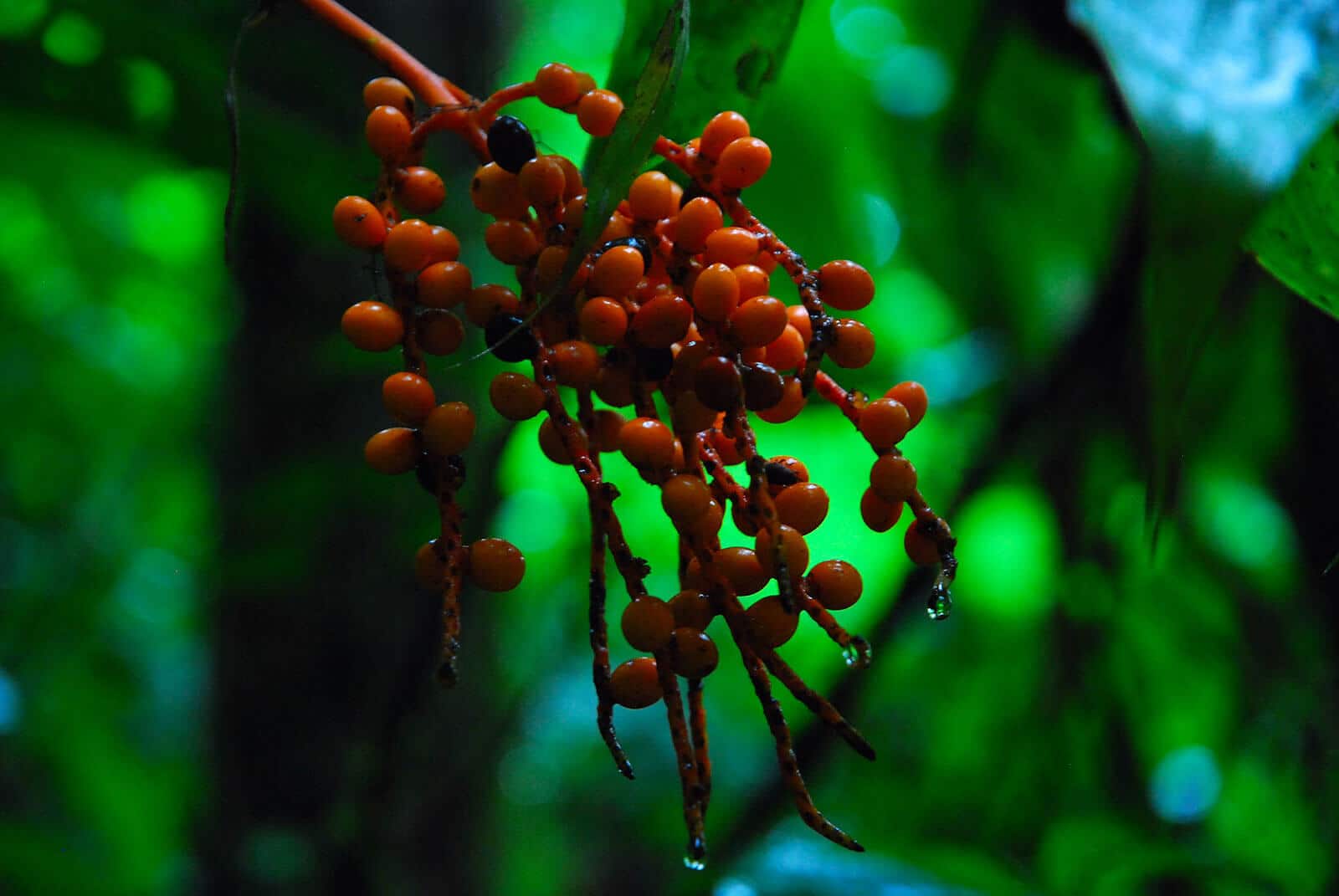
These days, we know that while tomatoes belong to the (very large and diverse) nightshade family, they definitely aren’t of the deadly nightshade variety.
This ambivalence was later reflected in the tomato’s other accepted scientific name, Lycopersicon esculentum (translated to “edible wolf peach”).
As you can see, the bad rap bestowed on tomatoes is simply an old wives’ tale, left over from a less-informed era.

Myth #2: Tomato leaves contain toxic compounds called alkaloids.
As mentioned in my previous post on carrot tops, all vegetables contain alkaloids. Alkaloids are part of a plant’s defense mechanisms (existing in all parts of the plant to protect against certain animals, insects, fungi, viruses, and bacteria) and we consume them on a daily basis in various amounts.
That locally-grown heirloom bean and kale salad you had for lunch? Alkaloids. Those antioxidant-rich organic green smoothies you make every week? Major alkaloids.
While it’s true that some alkaloids are not good for you (like nicotine and cocaine), others can be good or bad, depending on your view (like theobromine, the stimulant found in chocolate, or caffeine, that Monday-morning life-giver).
Even though alkaloids are present in your everyday veggies, you could never eat enough of them in one sitting for the alkaloids to be harmful.
So what gives with tomatoes?
The major glycoalkaloid in the tomato plant is tomatine. (To put it simply, a glycoalkaloid is an alkaloid bonded with a sugar.)
Tomatine exists in all green parts of the plant, including the stems, leaves, and green tomatoes.
(For the sake of clarity, whenever I mention “green tomatoes” in this post, I’m referring to the immature, unripened green tomatoes—and not the varieties of naturally green tomatoes.)
A study published in the Journal of Agricultural and Food Chemistry found that the highest concentrations of tomatine were found in senescent leaves, followed by the stems, fresh leaves, calyxes, green fruits, and finally, the roots (which had the lowest concentrations).

The difference in concentration between the fresh leaves and green fruits is negligible, so one isn’t necessarily “safer” to consume than the other. While tomatoes do show a decline in tomatine content as they mature and ripen, no one has ever thought twice about devouring a heaping of fried green tomatoes or pickled green tomatoes!
Recipe to try: Roasted Green Tomato Salsa Verde
Glycoalkaloids are also poorly absorbed by the gastrointestinal tract of mammals, and will pass through quickly to the urine or feces. In people who are sensitive to these compounds, stomach irritation may occur but they would have to ingest an unrealistic amount of green tomatoes or tomato leaves to experience ill effects.
So what’s the deal? Are tomato leaves poisonous or not?
Disclosure: If you shop from my article or make a purchase through one of my links, I may receive commissions on some of the products I recommend.
In the book Toxic Plants of North America, the authors wrote that a toxic dose of tomatine for humans would appear to require at least a pound of tomato leaves, and that “the hazard in most situations is low.”
According to this food safety study (which compared the potential toxicity of glycoalkaloids found in tomatoes, potatoes, and eggplants), tomatine is a relatively benign glycoalkaloid. It resulted in no significant changes to liver weight or body weight when fed to mice, and is not considered adverse to human health.
Another study has shown tomato leaves and tomato stems to have higher antioxidant activity and polyphenols (plant-based micronutrients that help fight disease and improve overall health) than tomato fruits.
What’s most surprising is the discovery of tomatine as a cancer inhibitor. The glycoalkaloid has been found to effectively kill or suppress the growth of human breast, colon, liver, and stomach cancer cells.
This study suggests that consumers could benefit from eating high-tomatine green tomatoes, and that there may be a “need” to develop high-tomatine red tomatoes as well (for the treatment of cancer and/or the study of tomatine as an anti-carcinogenic and anti-viral agent).
Judging from these studies, and the lack of evidence that tomato leaves are toxic for human consumption, I’ll have to give Myth #2 a miss.

Myth #3: Dogs have died eating tomato leaves, so they’re definitely poisonous.
Somewhere along the way, you may have heard a story of someone’s dog dying because it ate a bunch of green tomatoes or tomato leaves. But is this cause for concern for you?
Here’s the deal: tomatine can be deadly for a dog if eaten in large quantities.
And the last part of that sentence is key—in large quantities.
Whether or not tomato leaves can kill a dog is very much a dose-dependent issue. As most pet owners know, dogs eat all kinds of crazy things and don’t really know when to stop.
If they have unrestricted access to your garden and haven’t been trained to stay away from plants, it’s very possible they’ll chow down all your tomatoes, leaves and all.
For small dogs, especially, this amount of ingestion can cause diarrhea and vomiting at best, or a hospital visit in the worst-case scenario. This goes for many other plants in your house and garden, not just tomato plants.
(The list of plants that are toxic to dogs is long and surprising: lemongrass, chamomile, tarragon, borage, milkweed, purslane, and various parts of apples, peaches, and grapefruits.)
Does toxicity to a dog equal toxicity to humans? Far from it.
There are other foods we eat freely that are known to be poisonous to dogs, such as chocolate, grapes, raisins, garlic, and onions. But the substances that are harmful to dogs don’t do the same damage to humans.
To date, there’s scant evidence in veterinary literature regarding the toxicity of tomato leaves. One study in Israel examined the possibility of livestock poisoning by feeding tomato vines to cattle for 42 days, but found no ill effects.

Myth #4: Organic gardeners make tomato-leaf sprays to kill pests, so that must mean tomato leaves can kill us too.
Tomato-leaf sprays are made by chopping and soaking tomato leaves in water, then using the sprays on various plants to control aphids.
Since tomatine, a glycoalkaloid, has fungicidal properties and is part of the tomato’s natural defenses, it makes sense that the compound could potentially protect against pests when extracted into a solution.
But theoretically, you could make a spray with any green part of the plant, like the stem (which contains even higher amounts of tomatine).
Unless you’re allergic to tomatoes, the tomatine in tomato-leaf sprays won’t harm you—and that’s why it’s used as an organic method of pest control.
Read more: Get Rid of Pests With This 2-Ingredient Homemade Insecticide
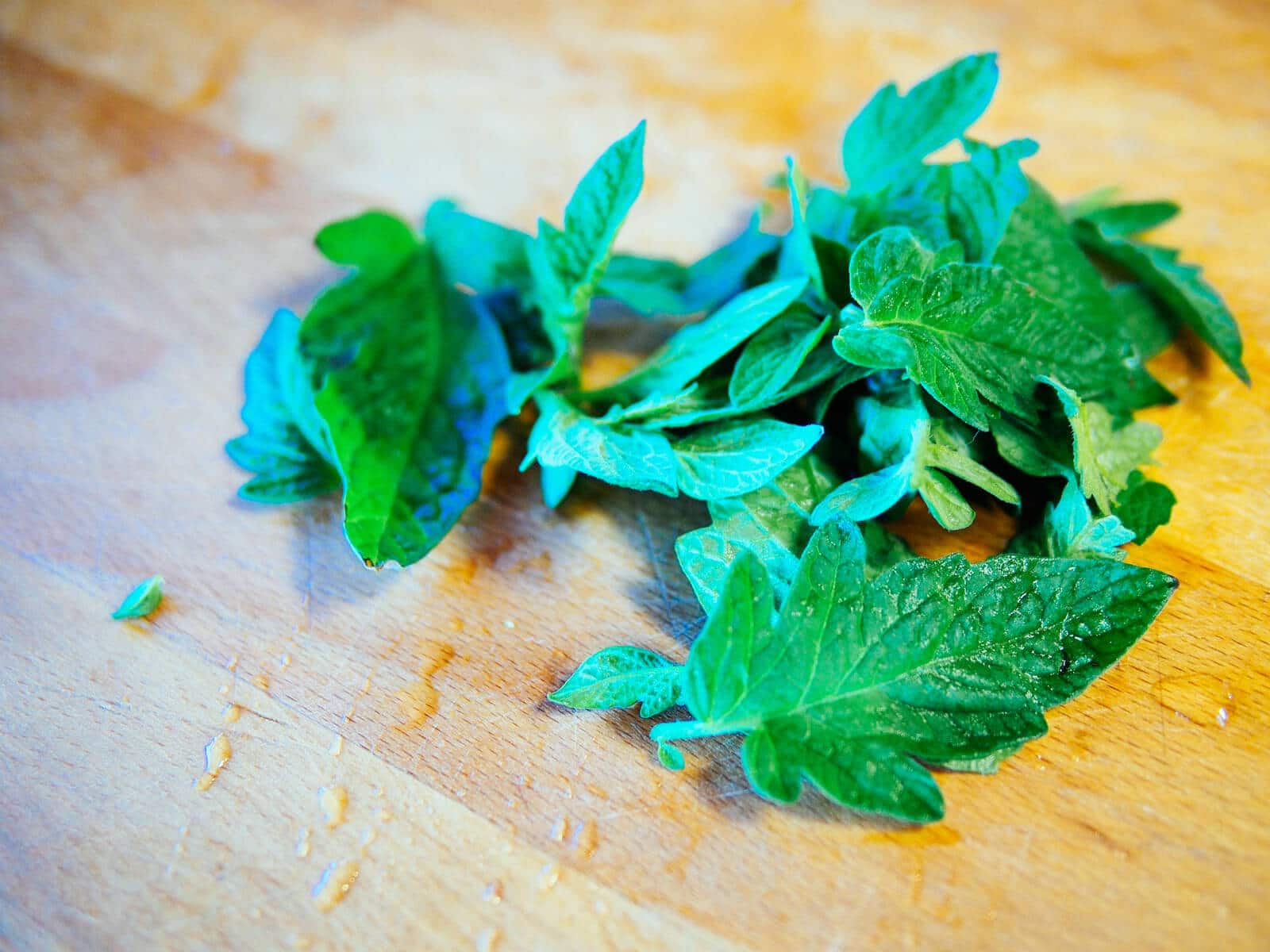
Myth #5: Tomato leaves aren’t sold commercially and no one has ever cooked with them, so that’s a sign they’re not meant to be eaten.
True, if you tried to Google recipes for tomato leaves, you aren’t likely to find any. In his book Cooking by Hand, former Chez Panisse chef Paul Bertolli included a recipe for leafy tomato sauce.
In The No-Waste Vegetable Cookbook, I have my own version of a spicy minty tomato sauce infused with tomato leaves, as well as tomato leaf pesto that’s delicious on pizza and sandwiches. Aside from those examples, however, not many people have stepped up and ‘fessed up to their culinary use.
But—and a big but—that does not mean they aren’t edible.
Until I started traveling to other countries, exploring their local cuisines, and cooking from my garden, I never knew all the possibilities of the plants I was growing.
(If you live anywhere outside of North America, you’re probably shaking your head at what we throw out!)
How else can you cook with tomato leaves? I’ve found it best used as an infusion so you can really capture the essence of a ripe summer tomato. Try infusing a handful of tomato leaves in olive oil (I love it as a drizzle on a Caprese salad) or infusing the leaves in tomato juice when you make gazpacho.
Another favorite technique is tossing thinly sliced tomato leaves with a bit of fish sauce, and using it as a savory garnish for rice or fish. Gently fried whole leaves of tomato also make a tasty topping for pasta, the way you’d fry sage leaves in browned butter. Dehydrated and crushed tomato leaves can be used as seasoning, perhaps folded into pizza dough or sprinkled over noodles.
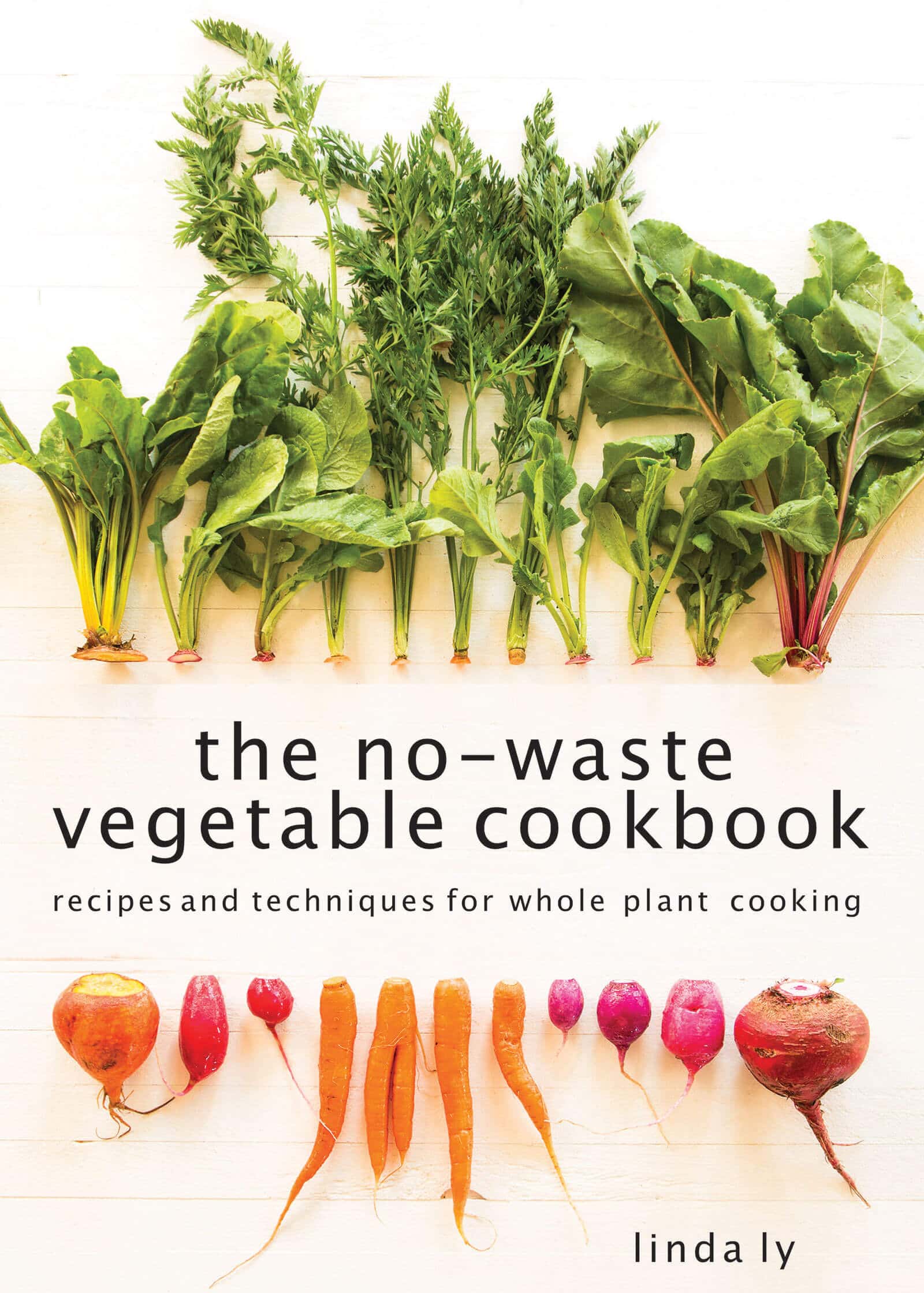
Waste less food. Get more nutrition. All with the same vegetables you already know and love.
The No-Waste Vegetable Cookbook is your guide to everything edible from all the plants you grow or buy — things you might not have known you could eat.
As for the rest of my garden, an adventurous appetite has led me to discover how delicious broccoli leaves are (you won’t find many recipes for those either), as well as carrot tops, nasturtium pods, radish pods, radish greens, and pea shoots (which are actually an Asian grocery staple).
Learning how to use the entire plant is my favorite “lazy gardening” strategy because it means I can get more food out of my garden with a lot less work.
The fact that tomato leaves aren’t part of the mainstream American diet doesn’t make them toxic by any means. People just don’t know what to do with them… yet. (Hopefully this will change in my generation.)
You know what is toxic though? The amount of food we waste in this country, and how Americans lead the world in food waste.

Conclusion: So, can you eat tomato leaves?
Contrary to popular opinion, yes—tomato leaves are flavorful, fragrant, and 100 percent edible. You can cook the fresh, young leaves like most other sturdy garden greens, such as kale, collards, or cabbage (leafy greens that need a little longer cooking time to become tender).
But personally, I like to use tomato leaves as an accent, where their strong herbal aroma adds a unique depth of flavor that you can’t get from tomato fruits themselves.
More tomato growing posts to explore:
- Grow Tomatoes Like a Boss With These 10 Easy Tips
- How to Grow Tomatoes in Pots—Even Without a Garden
- How to Best Fertilize Tomatoes for the Ultimate Bumper Crop
- How to Repot Tomato Seedlings for Bigger and Better Plants
- Why and How to Transplant Tomatoes (a Second Time)
- Planting Tomatoes Sideways: How Growing in a Trench Results In Bigger Healthier Plants
- Florida Weave: A Better Way to Trellis Tomatoes
- Conquer Blossom End Rot and Save the Harvest
- Can You Eat Tomato Leaves? The Answer Will Surprise You
- Why Tomato Leaves Have That Unique Smell
- The Power of Fermenting and Saving Tomato Seeds
- 4 Fastest Ways to Ripen Tomatoes in the Garden and Beat the First Frost
- The 30 Best Tasting Heirloom Tomato Varieties (By Color!)
- 83 Fast-Growing Short-Season Tomato Varieties for Cold Climates
- The Best Time to Pick Tomatoes for Peak Quality (It’s Not What You Think!)
This post updated from an article that originally appeared on August 20, 2013.
View the Web Story on eating tomato leaves.


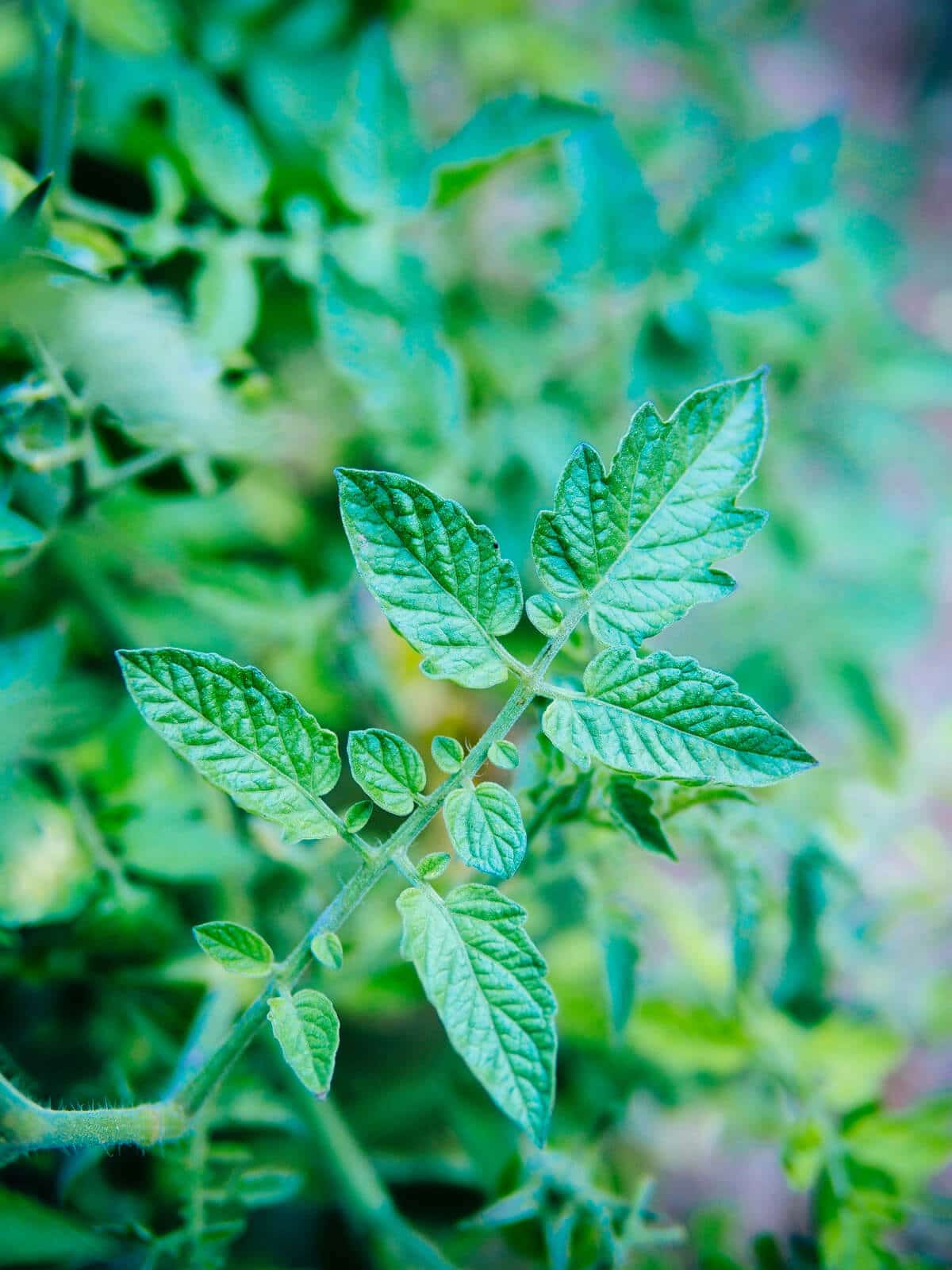













Great post!!! I will try cooking more with tomato leaves. Another leaf commonly used in other countries are pumpkin leaves. They are so buttery and delicious, and have none of the bitterness associated with other greens such as kale.
I love pumpkin leaves! They’re very common in Asian cooking. My favorite farmers’ market in Southern California (where I used to live) had a vendor that carried pumpkin leaves every summer.
I recently discovered that radish greens are delicious as pot greens! They are slightly bitter, about like broccoli rabe.
I’ve always loved cooking radish greens. Here’s a very, very old post (from 2010!) where I shared a basic recipe for radish green soup: https://gardenbetty.com/my-first-harvest-of-the-season/
What about blending the vines, leaves and fruit? I have vines that are still growing and it’s october 23rd. They will keep growing until Nov 1st or later.
I don’t think a blend of 100% vines, leaves, and fruit would be all that palatable. I use the leaves sparingly in sauces and soups to complement other flavors, not to act as the ONLY flavor.
I also grow own vegetable, banana, fruits trees, etc. Good to know you are doing this.
The article doesn’t mention anything about calcitriol, Calcitriol is a super active form of vitamin D produced in the kidneys. It is produced on demand, and it controls that amount of calcium that is absorbed by the gut. When you eat nightshades you are adding a lot of endogenous calcitriol, putting your body in danger of over-absorbing calcium. I got arthritis when I was thirteen. By the time I was forty I could not run, could not swim a crawl, or throw a ball overhanded. I am now 67, and have been nightshade free for seven years. I can do all of those things without pain, but if I want to remember hot life used to be, all I have to do is start eating nightshades again.
Sooooooo… the article doesn’t mention anything at all about your own personal experience eating tomato leaves..? Have you tried them yet? What was your experience?
Yes, and I do mention how I use them in previous comments here. I have two recipes in my first book, The CSA Cookbook, that use tomato leaves – one for tomato sauce and one for pesto. I’ve also added tomato leaves to sandwiches and scrambled eggs, mostly as an accent to those meals. A few sprigs are also good in tomato soup or minestrone soup.
Thanks. I wasn’t scrolling through and reading the comments.
This article doesn’t really educate people. It tells some technical truths but not practical.
Each person should be aware of the toxins in case they are trying to diagnose some malady. If your health is fine then eat them to your hearts delight.
Many people with chronic diseases have problems eating nightshades. If your young and healthy, the body may excrete the toxins easier. As you age and eating a lot of nightshades, you can become more affected. If your chronically ill, your system may not be able to rid itself of excessive amount toxins over time or the added burden of the toxins to total toxins will cause health problems to worsen.
You may eat them today and feel good but 20 years down the road may be a different story. Toxins/antinutrients are in many other foods too. Phytates, Lectins, glutens are in grains. There is the BMC-7 toxin in A1 milk casein protein.
As stated in my article, toxins of varying levels are found in many plants we eat. I presented the facts based on scientific research but they should not be construed as medical or nutritional advice. Individuals with health concerns should always consult their doctors.
Best article I’ve read on the subject, and it’s very educational.
I’m very happy to hear that!
Yes, this “practical truth” is true of all food and all changing needs of the body. That universal makes this specific article no less educational, though. Many readers obviously consider the personal implications of technical truths. Information helps us form considered decisions. But thanks, Matthew, for bringing up the fact that “toxins” are present in many forms and foods.
Interesting! I was always under the impression that they were poisonous. Now I know otherwise!
They are poisonous. It’s the dosis that count. But they ARE.
Here’s the recipe! 🙂 http://gardenbetty.com/2013/08/spicy-minty-tomato-sauce-infused-with-tomato-leaves/
It’s an excellent use of the stems. In my book, The CSA Cookbook, I call for steeping the leaves (with stems) in tomato sauce to add a deeper layer of flavor.
I will try this once my garden is overgrown with giant tomato plants. Which will be soon! 🙂
hello everyone. I have read some of the comments of our friends around the world and I said how nice to be with these group discussing the usefulness of the useless parts of a plant. I am partly vegetarian and I can relate also what you are talking about…Well, for those who want to eat a famous Filipino dish aside from lechon, here is the recipe of chicken stew or locally known as Chicken tinola or
Tinolang manok (good for 4 persons)
Ingredients:
6 normal slices of chicken parts (2 legs, 4 breast parts of chicken and liver) all are properly washed, skinned and cleaned).
1 ordinary size of unripen papaya fruit ( properly paled, wash, sliced into 8 parts)
20 pieces of young pepper leaves ( washed)
2 lemon grass stalks (properly washed, rolled or tied
4 strips of thinly cut ginger
3 pieces of garlic,finely chopped
1 round onion , finely chopped
1 small size of margarine or 2 tbsp of cooking oil
1 tsp salt or knorr cube
1 liter of boiled water
PROCEDURE:
1. Place ingredients on the table. Put the chicken parts in a clean bowl marinated with a dash of salt, chili, and parsley powder combined with squeezed lemon or 2 lemonsito. Set aside for 10-15 minutes.
2. Sautee garlic, ginger and onion until brown in a clean pan.
3. Pour the marinated chicken. Simmer for 10 minutes. Transfer the contents in a kettle for proper boiling.
4. Add the boiled water. Boil for 20 minutes with the papaya, lemon grass and knorr cube. When the papaya is tender, time to add the pepper leaves. Salt to taste.
5. Serve each person with a bowl (mangkok) of 1 slice of chicken, 2 slices of papaya, and 5 leaves of pepper. Pour each bowl with soup. Chicken tinola is better served with jasmine rice, baked potatoes and baguette or french toasted bread.
Enjoy dining…
Sounds like a great recipe, thank you!
V good info..thanks
Nonsense! Everything Chinese is NOT wisdom. Just because the animals and plants exist, everything need not necessarily to be eaten. This is the fruit of wisdom.
When there are so many other good edible vegetarian food available why struggle with tomato leaves which even rabits do not eat!!
I’m not sure what rabbits have to do with whether or not you should eat tomato leaves. And I certainly wouldn’t call it a struggle to eat tomato leaves. You are free to eat what you like, but having an open mind goes a long way to discovering the wonders of this world.
Ugh. This comment above seems improper and racist… your opening to this article did not suggest what they are criticizing.
Mint, and most things aromatic, can destroy a rabbits digestive system causing death, but is completely fine for humans, and even cats. Also most roots are dangerous to rabbits including onion and garlic. Speaking of which, garlic, onion, tree nuts, and grape skins are chronic poison to dogs, doing permanent damage upon each consumption. On another note, capsaicin and ethanol are both poisonous to humans, and even oxygen and water are deadly at enough purity. Point being, don’t judge what humans can eat based on other animals, we are all unique; just because something’s concidered poisonous, doesn’t mean it shouldn’t be used, especially with acute poisons.
I can assure you dear tomato leaves and stems contain various high levels of C45H73NO15 Solanine ,I suggest you educate yourself adequately before spreading potentially harmful information to people based on your uneducated opinions ,furthermore I would urge anyone dubious to simply investigate C45H73NO15 then leave a comment.
https://en.wikipedia.org/wiki/Solanine – We are often told never to eat potatoes with green on them because they are poisonous, with solanine toxin. Some people do have bad reactions to eating tomatoes, even red ones, as well, just as some do from eating peanuts or other foods they are allergic to. Normally I wouldn’t use wiki as a source, but the article does give other sources.
I use tomato leaves in place of parsley for cooking because I don’t grow parsley and I have tons of tomato leaves. Very similar flavor, more so than other replacements like cilantro. Never have gotten sick.
I’ve always loved the smell of tomato leaves and thought it was a shame that they were inedible. Glad to know that’s not true; I’ll have to try some.
I just made a mixed leave salad that included tomato leaves which i Pruned from my Cherry tomato plants this morning, and I gave some to my bunny who also devoured them. I did expect more of a tomato flavour from the leaves considering how strong a tomato smell they give off… but not so. Still I will eat them in a blend of greens from now on. 🙂 thank you so much for this post.
That tomato leaf pesto recipe comes from my book, The CSA Cookbook! (Which Lisa, the blog author, reviewed.)
Can you post some recipes you made up or found on tomato leaves or stems etc.?
I often make this recipe in summer http://gardenbetty.com/2013/08/spicy-minty-tomato-sauce-infused-with-tomato-leaves/ and also offer a tomato leaf pesto recipe in my book, The CSA Cookbook. Some of the comments in this thread suggest other uses by readers as well.
“Toxic” is a word I dislike, as the properties of many plants can be toxic if ingested at a certain dose. I think people are just afraid of the unusual, leading them to think the plant part has to be toxic if they don’t recognize it as a food.
Hi, I’m going to make some soap with tomato juice from my garden, and I was wondering if I can use some leaves to add some smell instead of fragrance. I was afraid that it might be toxic. I’m from Poland and we eat a lot of solanaceae family veggi, but never leaves. Thank You for informative blog, now I’m giving it a try.
Tomato leaves aren’t toxic, though I don’t know how much fragrance they’d give off in soap.
Some people get skin reactions from tomato leaves (unrelated to the solanine or tomatine) – but that is probably true of any herbal addition to soap.
Well written, thank you.
You’re welcome!
What is a good less toxic pesticide for my tomatos? I found a big “worm” feasting on my unripe tomatos. could probably eat him but…. no. lol
There are a lot of different natural solutions for various pest problems, it just depends on what kind you have and the extent of it.
For hornworms, hand-picking and killing them is the best defense. You’ll have to stay on top of it throughout the season and check your plants a few times a week for them. Hornworms have many natural predators so it’s also a good idea to grow beneficial plants around your tomatoes to attract predators like ladybugs, lacewings, and parasitic wasps.
I never heard the warnings, thought the leaves smelled a little like celery, tossed some in my salad and they were great! Just a tad sharper then some of the other salad fare, like arugula (in strength, not flavor) it add a pleasant little punch. Once in a while ignoring, or being ignorant of the instruction works out just fine.
I’ve put tomato leaves in a panini with basil, cheese, and tomatoes as well. Delicious mix of flavors!
I agree. It’s definitely my Asian side that has taught me not to waste any parts of food. Last year I shared a recipe/article on my blog about eating sweet potato vines and leaves. So many people were amazed you could eat those. Growing up with a Korean mom and a dad from Appalachia has made my eating VERY diverse. I admit I haven’t tried tomato leaves, but I have often wondered how I might use them in a dish. Great article!
Thanks Debbie! I use tomato leaves as an accent; I love to steep a few sprigs in tomato sauce or tomato soup to give it a deeper layer of flavor.
And sweet potato leaves are delicious! I actually give recipes for these types of vegetables in my new book (The CSA Cookbook), and some of it is Asian-inspired as it pulls from my experiences of eating in my family’s kitchen.
Any green veggie leaves are delicious, I always cook it since I was very young, I agree as an Asian we don’t waste good. Till now, I grow : Long Bean, Papaya, tomato, and last but not least Banana leave for wrap the fish and steam it…Love in the Summer..All grow back after winter all dead.
I need to cook with my banana leaves more! I have so many. 🙂
I was taught by my European heritage never to waste food.
I’m pretty sure it’s a universal thing, especially where there is or has been poverty.
I love tomato leaves, cook just like Spinach….
And I’m still kicking…:)
Ripe tomatoes from a small, organic farm make me sick because my body now knows that it is bad for me. I can only eat them if they are cooked. In my past, I ate raw tomatoes often and I found that raw tomatoes give me arthritic symptoms, although sugar and canola oil can aid in arthritis more. If people eat the green tomatoes, this could be further proof that there is another danger, but it is broken down by heat.
Potatoes are highly poisonous, by the way. A lot of people eat the skin, which is almost as bad as a green potato. It is very high in solanine, which is proven to be toxic by all research done on it. Solanine prevents the breakdown of very important nutrients for the neural system (it is a cholinesterase inhibitor). While our body can make solanine safer and removes solanine within 12 hours, it still seems like eating potato skin often would have negative effects. The unripe tomato and the plant leaves should have solanine, but not as significantly high.
potatoes are highly poisonous? tell that to the millions of people who are still alive
Actually yes – with the same toxins as tomatoes: solanine and tomatine
https://www.smithsonianmag.com/history/how-the-potato-changed-the-world-108470605/
Also, many North Africans died from donated potatoes during a famine – not having the knowledge on how to limit solanine (like keeping them in the dark to avoid greening). Also, Europeans had built up a tolerance for solanine which the Africans lacked.
You should be equally cautious of potatoes and tomatoes.
Where did you get your information? Are you a Dr or scientist ?
I eat the skins all the time…. nonsense lol
You can eat the leaves of chile plamts as well!!!
Foraging is an excellent option if you live in the right neighborhood and know what to look for. And pepper leaves are delicious, I actually cover them (and other unconventional parts of plants) in my new book: http://thecsacookbook.com . 🙂
Thanks! happy nom nom nom!!!!
I might have some concern for what my urban neighbors might be spraying or dumping on those wild greens..personally
Absolutely nothing. Living in the high desert (5500 ft ASL) with water restrictions, lawns are on the natural side which means a minimum of turf and a minimum of maintenance. In the early spring when most fresh wild greens are at their prime, there is no yard work being done yet. I tend to harvest wild greens from areas that are not by roadways, sidewals, or where dogs are walked, etc. I am quite selective.
Love dandelion. I heard they are the most nutritious green there is. I pick them from the yard sometimes and add to my salad.
This is a great post. been wondering about the leaves myself after people called me crazy for buying the greenest tomatoes I could find.
In Ca. the check out girl must have thought I was crazy. Amazing that any actually made it to the store.
When thinking of fat and oils, these do not make you fat. What is making people so fat I can’t answer.
McDonald’s became famous for their fries back in the day. It was because they used Suet in their deep fryers. An especially bad animal fat. The reason it is so bad is because it congels at 98° and wont melt again until it reaches 113° Once in your human body it will stick around.
That is still not a reason so many people are fat today, a question that needs more study.
I am a fan of green tomatoes too! I like plants that can offer different tastes and textures throughout their lifespan… crisp, tart tomatoes at the beginning and end of the season, and rich, juicy, sweet tomatoes at their peak.
+TruAnRksT
No more study needed on this one! It´s been well documented that what makes people fat is sugar. And few things are as addictive. So the best decision you can make to keep your health is to stay away from this poison. A good start is to quit buying sugar in the store, and leaving the colas and sodapops alone!!
Also, wheat!
miracle grow
The immediate cause of fat in humans can be answered conclusively: insulin. It gets more complicated from there. Normally, insulin is secreted in response to high blood sugar. It is also secreted in response to anticipated blood sugar rises – like the sweet taste of diet soda or sitting down to a Thanksgiving feast, or viewing food porn. Yes, looking at food can literally make you fat.
Insulin signals fat cells to suck up glucose from the blood, converting it to triglycerides. This is needed because glucose is toxic at high levels. When blood sugar is low, fat cells convert triglycerides to glycogen, which then travels to the liver, and is converted to glucose.
Various things can go wrong in the machinery. When the result is high blood sugar, it is called diabetes – this can kill you. When the result is low blood sugar, it is called hypoglycaemia – this can kill you.
A few of the things that can go wrong:
Fat cells may fail to respond to insulin (insulin resistance diabetes), the liver may be genetically unable to convert glycogen to glucose (reactive hypoglycaemia), the pancreas may be genetically unable to secrete insulin (juvenile diabetes), the pancreas may be too damaged to secrete insulin (adult onset diabetes). The fat cells may not respond to low blood sugar and release sufficient glycogen (hypoglycaemia).
While it’s true that some alkaloids are not good for you (like nicotin show me that in proper dose nicotina cant be good for you.. look to medical journals mostly to cognitive function after nicotine. The dose make poison also many food contain nicotine.
Interesting. I love using different parts of veggies I grow or purchase at farmers markets that often sell you the vegetable with everything on (unless they take it off to compost of feed farm animals). My dad composts and i sometimes bring him my waste, but I often love using the leaves and stems in broth, in my joucier machine and also to use whole. I made zuchini leaf cream soup and it was good, fried zuchini blossons are good and the flowers are actually sold in farmers markets. I grow tomato plants, now the tomato leaves would be old and bitter as the seasons to an end, but its probably nice to use when young. Im often afraid of ruining thr plant, soni use leaves sparingly from plants I know are safe.
I too strive to cook with as little waste as possible (especially if I grew it myself… I just think of all the work that went into it!). My first book, The CSA Cookbook, comes out March 2015 and has recipes for all the different parts of plants you typically discard: carrot tops, tomato leaves, pepper leaves, bean leaves, etc. I think you’ll like it, as you seem to have a curious and adventurous appetite. 🙂 http://thecsacookbook.com
I just want to say (without reading all the comments) that I believe you are wrong. Deadly nightshade and Bella Donna are two different plants. Bella Donna also known and Angels Trumpet is quite different and tree like with HUGE white flowers compared to the creeping vine, purple flowers and red berries of the “deadly nightshade” plant.
So please be careful people. 🙂
Angel’s trumpet is NOT belladonna. Angel’s trumpet is the common name for Brugmansia and Datura, which are closely related members of the Solanaceae family. (It is also the common name for Maurandya barclayana, an entirely unrelated plant in the Plantaginaceae family.)
As stated in my article, deadly nightshade and belladonna are both common names for Atropa belladonna. Atropa belladonna is not the same plant as angel’s trumpet and is never referred to as angel’s trumpet.
These are facts that can be verified in any botanical text should you desire additional information.
Datura – Typically “Devil’s Trumpet” (trumpet pointing up or sideways)
Brugmansia – Typically “Angel’s Trumpet” (trumpet pointing down)
Thank you for clarifying! I have heard the term devil’s trumpet associated with Datura as well.
I love how you can find unexpected flavor in the parts of plants that are generally not used.
When i was young in the Philippines, my mum used to cook Ampalaya Leaves (bitter gorge) or Sayote leaves (those younger part only) and mixed it to a Filipino popular dish like Pinakbet. Thanks and i love your article.
One of my favorite Filipino dishes is tinola. My dad (Chinese) uses pepper leaves in a similar soup. The flavor is wonderful!
I like the link you left about olive oil. Very good information. I sure you have probably checked out the benefits of coconut oil as well.
Cooked tomato leaves smell like spinach! Just cooked up a batch to try as a bug buster. But I will try them in cooking. Thanks for this article.
When the suckers on my tomato plants reach a certain size, i cut them off and keep them for growing plants for the fall I remove the bottom leaf off each sucker and blend it with water and stevia. It has a very mildly mint taste. I don’t drink it all at once I drink, maybe one cup through out a day.
Interesting, I’ve never thought to turn it into a drink!
Wonderful and historic, high value article! Thank you and I am going to get tomato leaves and make a dish with it 😉
I love this idea! What do they taste like?
Kind of vine-y, if that makes sense. Very deep and earthy.
Thank you for your thorough information. I am teaching gardening skills to 850 students ages 3-12. A parent donated some tomato plants with a stern warning about the “poisonous leaves.” She told me to have the children wash very well immediately after touching the leaves. I hadn’t heard of such a thing! You have provided great evidence to support my continued “students do all” approach to our garden.
I’m glad to hear it! Tomato leaves certainly aren’t poisonous to the touch, but as with any plant, certain people with sensitive skin might have an allergic reaction.
Thanks for clearing things up about tomato leaves! I’m currently working and living in Malawi, where I’m growing tomatoes, amongst other crops… and having a bit of an aphid and fungus problem. Whilst making tomato leaf insecticide spray, I wondered if those leaves were actually toxic or not.
My Malawian guard actually eats them, and says they’re quite widely eaten in Malawi. I actually warned him that they may be toxic, but will tell him otherwise.
Thanks for the great blog – you have a new follower!
PS. I too, I love broccoli stems that taste like kohl rabi, and leak greens, which are more flavoursome than the white parts.
Thank you James! And I’m intrigued about the use of tomato leaves in Malawian food. I’d love to know how they prepare them.
Nearly 30 years ago, while in high school, I was interested in ninjas and samurais etc, and I read some books about them, and I read that ninjas used tomato leaves to poison their victims by secretly mixing them in with their victim’s salads. Ever since then I’ve wondered if it’s true, and finally I decided to look it up and I found your wonderful blog. Thank you for setting the record straight. By the way, I really love your writing style, and I hope to read more from you.
That’s so interesting about the ninja stories! Thankfully, it’s not true… and I wonder if they were actually using deadly nightshade but the plant names got lost in translation?
Thanks for stopping by my blog, and I hope you continue to stick around!
FYI, at one of Sydney’s best restaurants, The Bridge Room, Chef Ross Lusted uses dried tomato leaves in a few dishes. Very delicious. Funny we don’t use them more!
Dried tomato leaves sound so interesting! I’ll have to try a few next summer and see how they taste.
The reason I am here is that I grew tomatoes in a greenhouse for the first time. The things are monsters now. I had to do some pruning and most of that ended up in the compost pile. Today I found a leaf I missed laying on the shelf. It was so dry you could hardly pick it up without it crumbling. Well I gave it a sniff and it smelled like alfalfa hay. So here I am looking to see if I can eat it. It smelled so good. Thanks to you Linda I tasted the dried crumbled tomato leaf. It taste just like alfalfa hay.